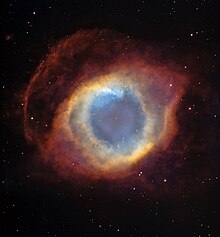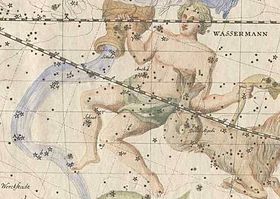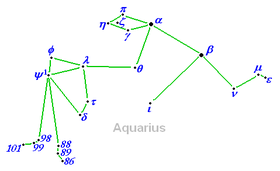Aquarius (constellation)
Aquarius (the water bearer or amphora), is one of the 88 constellations recognized by modern astronomy, described by Claudius Ptolemy. Its symbol represents the flow of water.
Of the entire zodiac, Aquarius is one of the oldest recognized constellations. The Sumerians gave this name to the constellation, in honor of their god An, who pours out the water of immortality on Earth. It is located in a region commonly called the Sea or Aqua for the profusion of aquatic constellations such as Cetus, Piscis, Eridanus. Sometimes the Eridanus river is represented as the pouring out of the Vessel of Aquarius.
Notable features
The constellation Aquarius is the 10th largest constellation, covering more than 2.3% of the night sky. It includes 56 stars observable with the naked eye, mostly dim, Sadalsuud (β Aquarii) being the brightest at magnitude 2.90. The second brightest star is Sadalmelik (α Aquarii), a yellow supergiant of spectral type G2Ib—very similar to Sadalsuud—with a radius about 60 times that of the Sun. Sadalmelik, Sadalsuud, and Enif are thought to be (ε Pegasi), with similar age and mass, have a common origin.
The two yellow supergiants are followed in brightness by δ Aquarii, known as Skat, a white main-sequence star of type A3V located 160 light-years from Earth. Another bright star is ζ Aquarii, named Sadaltager, a binary composed of a white-yellow main sequence star and a slightly cooler subgiant. The subgiant could itself be a spectroscopic binary.
Aquarius contains several red giants, the brightest of which, λ Aquarii, is named Hydor. It has a radius 100 times greater than the solar radius, equivalent to 0.5 AU. φ Aquarii, of spectral type M2III, has a more modest size, about 35 times larger than that of the Sun. Not so χ Aquarii, which is similar in size to Hydor but almost twice its distance away. Finally, 3 Aquarii is also a red giant —type M3III— similar to χ Aquarii and Hydor. Like these, it is an irregular variable.
Among the constellation's variables is R Aquarii, a symbiotic star thought to be composed of a white dwarf and a Mira variable forming a binary system. Due to its gravitational pull, the white dwarf pulls in matter from the red giant and occasionally ejects some of it in strange loops that form a nebula surrounding the star. Another variable of interest is AE Aquarii, a DQ Herculis type cataclysmic variable: It is an interacting binary where there is mass transfer between the two components, a white dwarf and an orange star; Furthermore, AE Aquarii constitutes the first case in which a white dwarf behaves like a pulsar, emitting high-energy X-ray pulses.
Aquarius contains several stars with planetary systems, including the red dwarfs Gliese 849 and Gliese 876, the latter with four planets. The two planets in Gliese 849 have long orbital periods of 1924 and 5520 days. TRAPPIST-1 is an ultracool red dwarf of spectral type M8V that hosts a system of seven planets; at least three of them orbit in the circumstellar habitable zone. Very different is ψ1 Aquarii, an orange giant of spectral type K1III with a planet that orbits 0.70 AU from it. Bosona (HD 206610) is also a similar star with a giant planet in an eccentric orbit (ε = 0.23).
This constellation includes GJ 1276, one of the coldest white dwarfs known. With a surface temperature of only 4000 K, its estimated age—as a stellar remnant—is 8.48 billion years. It is located at a distance of 27.8 light years.
Globular cluster M2 is located in Aquarius, one of the most compact known. Contains 150,000 stars, including 21 variables. It is 13 billion years old, making it one of the oldest star clusters associated with the Milky Way. Another globular cluster is M72, located 53,000 light-years away and lying a considerable distance beyond the galactic center.
Also in this constellation is the Helix Nebula (NGC 7293), a spectacular planetary nebula some 655 light-years away, making it one of the closest to Earth. Due to its characteristic appearance, in the Popular culture has been nicknamed "God's Eye". Another planetary nebula in Aquarius is the Saturn Nebula (NGC 7009), with a complex structure. This includes a halo, jet streams, multiple shells, as well as ansae (handles) that expand non-radially from the central star.
Main Stars
- α Aquarii (Sadalmelik), yellow supergiant star of magnitude 2,95 that is 760 light years.
- β Aquarii (Sadalsuud), the brightest of constellation with magnitude 2,90, and of characteristics very similar to Sadalmelik.
- γ Aquarii (Sadachbia), binary star of magnitude 3,86.
- δ Aquarii (Skat), white star of magnitude 3.27.
- ε Aquarii (Albali), white-azulada star of magnitude 3.75.
- γ Aquarii, a binary system consisting of two white-yellow stars separated 1,67 seconds of arc.
- η Aquarii, white-sluggish star of magnitude 4,02.
- θ Aquarii (Ancha), yellow giant at 191 light years away.
- λ Aquarii (Hydor), an irregular red variable giant whose brightness varies between magnitude 3.70 and 3.80.
- Aquarii, a yellow-orange giant of magnitude 4.50.
- ο Aquarii, white-smooth subgiant and Be star of magnitude 4.70.
- φ Aquarii, white star of magnitude 4,69.
- π Aquarii (Seat), white-blue color is a Be star and a Gamma Cassiopeiae variable.
- υ Aquarii, yellow dwarf of magnitude 5,20 that with a star companion discovered in 2005.
- φ Aquarii, red giant whose characteristics are almost identical to those that our Sun will have within 7600 million years.
- Aquarii χ, red giant and irregular variable but less bright than Hydor.
- END Aquarii, gives name to three different stars: /25070/1 Aquarii, an orange giant with a planet, /25070/2 Aquarii, white-azulada variable star, and ANTE3 Aquarii, white binary star. The magnitude of the three stars is between 4,20 and 5,00.
- ω1 Aquarii and ω2 Aquarii, the first one white subgigant of magnitude 4,99 and the second one white-azulada star of magnitude 4,48.
- 1 Aquarii, red giant of magnitude 5.15.
- 11 Aquarii, yellow dwarf of magnitude 6,21 hotter and brighter than the Sun.
- 25 Aquarii (d Aquarii), an orange giant of magnitude 5,11.
- 53 Aquarii, binary system composed of two solar analogs.
- 77 Aquarii, an orange giant of magnitude 5.56.
- 88 Aquarii (c2 Aquarii), bright orange giant of magnitude 3.68, fifth most brilliant star of constellation.
- 94 Aquarii, multiple star whose main component is a yellow sub-gigant of magnitude 5.19.
- A Aquarii, a symbiotic star composed of a white dwarf and a Mira variable.
- AE Aquarii, a cataclysmic variable whose main component, a white dwarf, shows a behavior similar to that of a pulp.
- EN Aquarii (3 Aquarii), red giant and irregular variable similar to Aquarii χ, although something brighter than this.
- ET Aquarii (108 Aquarii), variable star Alfa2 Canum Venaticorum whose magnitude ranges from 5.12 to 5.21.
- EZ Aquarii, triple star system at only 11.3 light years.
- FK Aquarii (Gliese 867), star system with chromosopheric activity; its components are red dwarfs.
- HD 210277, yellow dwarf colder and less luminous than the Sun; around it an extrasolate planet has been discovered.
- Gliese 876, distant red dwarf 15.3 light years that has several planets orbiting around, one of them a terrestrial planet.
- Gliese 849, also red dwarf with an extrasolate planet.
- Wolf 940, binary system formed by a red dwarf and a brown dwarf.
- Gliese 884, orange dwarf at 26.6 light years.
- GJ 1276 (WD 2251-070), very old white dwarf; its age as star remnant can exceed 7 billion years.
- BD-22 5866 (LP 875-68), quadruple star system whose components are very close to each other.
- TRAPPIST-1, an ultra-cold red dwarf star that houses a system of seven planets.
Deep Sky Objects
There are three deep sky objects that are in the Messier Catalogue:
- Glybular cluster M2, one of the richest and most compact ones known. Distant 37 500 light years, contains 150 000 stars, including 21 variable stars. Its central part is quite compact: the dense central core of the cluster has only 20 seconds of arc diameter, which corresponds to a diameter of 3.7 light years.
- M72, another globular cluster. Of apparent magnitude 9 or 10, it is one of the most luminous intrinsically globular clusters, since it is 53 000 light years.
- M73, actually an asterism and not a true open cluster.
There are also two planetary nebulae:
- Nebula Saturno (NGC 7009), southeast of Cristian Aquarii. The central star is of apparent magnitude 11,5. It has a luminosity—in the visible spectrum—about 20 times greater than that of the Sun but emits most of its radiation as ultraviolet light. Hugely hot, its temperature is 90 000 K,
- Helice Nebula or Hélix Nebula (NGC 7293) southwest of δ Aquarii. Distant about 680 light years of the solar system, it is one of the nearest planetary nebulae. Despite its large apparent size, it is a difficult object to see due to its diffusion, requiring dark skies and the use of instruments as bright as possible, such as prismatics or a telescope operating at low increases. It was discovered by Karl Ludwig Harding before 1824.
Other objects to highlight are:
- NGC 7492 globular cluster, far from the center of our galaxy.
- Spiral Galaxy NGC 7727.
- Aquarium Enana Galaxy, irregular galaxy. Its membership in the Local Group was established for sure only in 1999. Its distance to the Milky Way is 3.2 million light years, which implies that this galaxy is quite isolated in space. It is also one of the less luminous galaxies of the Local Group.
Mythology
The well-known myth identifies Aquarius, who was also known as escanciador, with Ganymede. Ganymede is the son of Laomedon, king of Troy. His father entrusted him with the task of guarding the herds in the mountains. He was, according to the stories, one of the most beautiful mortals, in such a way that Zeus, father of the gods, fell madly in love with him and turning into an eagle (another constellation) kidnapped him and took him to Olympus. As compensation Zeus gave the boy's father immortal divine steeds. On Olympus Ganymede becomes the divine cupbearer in charge of serving the gods.
Aquarius generally represents the figure of a man, and when considering the stars that for a human being are very dim or indistinct to see, he takes the figure of a man with a jug which spills a liquid.
Aquarius has also been identified as Deucalion, the one who saved himself and his wife Pyrrha from the universal flood sent by Zeus, in the Greek version of the myth.
Alternate View
The stars of the constellation Aquarius can be connected in an alternative way, which graphically shows a running water carrier while carrying a vessel from which water spills.
The head of Aquarius is formed by the quadrangle of stars α Aqr, γ Aqr, η Aqr, and π Aqr: α Aqr being of third magnitude. The star ζ Aqr, which is housed within the quadrangle, represents an eye.
The torso of Aquarius is formed by the stars α Aqr and β Aqr, with β Aqr being of the third magnitude.
The left leg of Aquarius is formed by the stars β Aqr and ι Aqr; and the right leg, by the stars β Aqr (which is the point of union between the two legs), ν Aqr, μ Aqr, and ε Aqr, the latter two representing a foot.
The arm is formed by the stars α Aqr, θ Aqr, and λ Aqr, with λ Aqr being the hand.
The water carrier carries a vessel, perhaps a jug, which is made up of the stars ψ¹ Aqr, φ Aqr, λ Aqr, τ Aqr, and δ Aqr. The top of the vessel consists of the triangle of stars ψ¹ Aqr, φ Aqr, and λ Aqr.
The water spills out of the pot in two lines. The left line is made up of the stars ψ¹ Aqr, 98 Aqr, 99 Aqr, and 101 Aqr. The line on the right is made up of the stars ψ¹ Aqr, 88 Aqr, 89 Aqr, and 86 Aqr.







